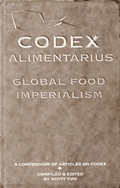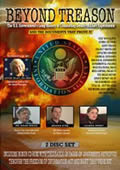THE
MUSLIM BROTHERHOOD
PART 2 of 2
By
Jon Christian Ryter
March 20, 2011
NewsWithViews.com
The Brotherhood's Not Exactly Soulmate
In 1936 al-Banna forged a political and military alliance that worked for him. It was a political protocol with Nazi Germany. While al-Banna and Adolph Hitler were not exactly soulmates, the arrangement brokered by al-Banna was far more than just a marriage of convenience. Both al-Banna and Hitler were bent on world conquest. Both wanted to completely subjugate and dominate every living soul on Earth. Both were supremacists. And, most of all, both hated the Jews. Both believe in transnationalization and the eradication of the nation-state (as does the New World Order today). In Hitler's vision of the future, he was the leader—the Fuhrer (the Father) of the world. In al-Banna's vision, he would be the Caliph. Perhaps the 12th Caliph, whom the Muslim prophecies say will rule the whole world from Jerusalem. They were soulmates paired in Hell. The parallels between them facilitated the alliance of convenience. Both knew that the day would come when one would subjugate the other. Both were convinced they would prevail.
During World War II the Muslim Brotherhood formatted a formal alliance with the Nazis, urging Berlin to help him depose Egypt's King Farouk. In exchange, the Brotherhood would aid the Nazis with real time intelligence from Brotherhood members within the government, and supply the Nazis with dossiers on the key members of Farouk's government. Al-Banna supplied far more to the Germans than he got in return. At war's end, Farouk was still alive. He was deposed by the Muslim Brotherhood in 1952, and surrendered his throne to his infant son, Ahmed Fuad, who became King Fuad II. Farouk died in exile in Italy on March 18, 1965.
In 1948, when the United Nations voted to reestablish the State of Israel which had not existed since 586 BC—or for 2,534 years, al Banna and Amin al-Husseini urged the Arab world to unite in opposition to the resolution. (Some would claim the actual demise of Israel came in 333 BC when Alexander the Great defeated Persia and conquered Judea. When Alexander died, his kingdom was divided into four Empires, with Judea becoming part of the Seleucid Empire. If 2,281 years fits your chronology, so be it. Anyway you count it, Israel was not Israel for a long time. The prophecy of its rebirth is found in Ezekiel 37:1-14. So whether you add or subtract the additional 253 years from someone's historic yardstick, no ancient land has been reborn in current times.)
The resolution to create the State of Israel would have also created the State of Palestine. But finding a home for the gypsy Palestinians (whose ancestors were the offspring of unions between Syrians and Jews and Persians and the Jews who were left behind during the Assyrian and Babylonian captivities) was not a simple task. No Arab wants them as a neighbor. Nor do the Jews. While the Palestinians are ancestral Muslims, they are no one's friends and everyone's terrorist pawns in the Mideast.) Over the centuries, you might say, the Jewish blood that coursed through their veins was adequately diluted with Arab blood, but that Jewish blood still remains as a stain on their Islamic identities.
With their influence in Egypt rising, and with the Egyptian government uncovering a plot by the Muslim Brotherhood to assassinate several members of the Egyptian government, Prime Minister Mahmoud an-Nukrashi Pasha outlawed the group in December, 1948 and seized all of its assets. Several Brotherhood members were rounded up and jailed.
In January, 1949—less than three weeks after the Brotherhood was disbanded—Pasha was assassinated. On February 12, al-Banna was also shot and killed by an assassin (whom the Brotherhood believed was a government agent or military officer) The Ikhwan's second leader, Isam al-Attar was less prone to violence than al-Banna, and rejected violence in the struggle to prevent Saddam Hussein's Baath Party from seizing power in Iraq. By contrast, most of the senior Brotherhood leaders and most of the young activists who saw an armed struggle and terrorism as the only strategy that would help them achieve their objective—world subjugation. In the end, the more militant faction, headed by Abd al-Fatah abu-Ghuda won out and al-Attar was deposed. A new, and more violent generation of radical Islamists took over the movement. Most were students of the radical Wahabbi teachings of Sayyid Qutb, whose teaching argued that governments which fail to incorporate Sharia into all aspects of life are heretical and, that government, is illegitimate and most be overthrown.
The Brotherhood in Syria
In the 1940s the Muslim Brotherhood flourished in Syria thanks to the French Foreign Legion. Various Islamic groups formed under the rubric of the Muslim Brothers (al-Ikhwan al-Muslimun), making Syria the first nation after Egypt where the seeds of the Ikhwan movement were planted. Mustafa al-Siba'i led the Syrian armed struggle against the French. In 1946 the French left. Between 1946 and the Ba'ath coup in 1963 that brought Hafiz al-Assad to power, the Syrian Ikhwan was a part of the political system, increasing its seats in Parliament from 2.6% in 1949 to 5.7% in 1961.
In 1980, Hafiz Assad's parliament enacted Law No. 49 which mandated the death penalty for members of the Ikhwan. At the same time, the Ikhwan joined forces with other opposition groups in Syria—including Kurds—who were determined to overthrow the current regime.
This is something those studying the Muslim Brotherhood should note. The Ikhwan does not hesitate to forge alliances with anyone who wants to destroy their enemy. The adage, "the enemy of my enemy is my friend," fits the Ikhwan since it will not hesitate to forge alliances with those with whom it differs—even ideologically—if that alliance will help them destroy a stronger enemy. Once the stronger enemy is defeated, it can then deal with the no-longer-needed ally. That is why, in 2006, the Muslim Brotherhood joined the National Salvation Front, which is determined to end the regime of Bashir Assad. And why, in 2009, it broke with the NSF and met with Assad, convincing him that they were no longer part of the group attempting to overthrow him. The ideological shift and what the media called a "historic reconciliation" with the Assad regime was simply a ploy to reestablish themselves in Syria. It worked.
End Game
The world is now seeing the results of those alliances. What does not show, in public, are the fingerprints of the Muslim Brotherhood. In fact, the Muslim Brotherhood is now deeply rooted in 80 countries—that's about 43% of all the nations on Earth. When they conquer the Muslim nations, the non-Muslim nations will be next. We are watching the opening plays in the Muslim Brotherhood's end game. It's hard to see them manipulate the game since they are smart enough to work in the dark in order to make sure their presence, and their identity is not front and center. The world watched the Muslim Brotherhood toppled the governments of Tunisia and Egypt. And, it will topple the governments of Syria and Libya. And, the mainstream media will continue to call it a "freedom movement." And what is even worse, the industrial nations of the world, through the European Commission and NATO, are actually helping them gain the power they need to force every nation on Earth to adopt Shar'ia law and convert to Islam or suffer the consequences.
As the Muslim Brotherhood orchestrated the gameplay in the Egyptian coup, the media reported that the historic event that took place in Tahrir Square in Cairo that launched a revolution was orchestrated by college students and young professionals using the social networking sites, Facebook and Twitter that was inspired by their peers in Tunisia. So says the media. What do the people who were there, say? According to Egyptian analysts and many of the those in involved in leading the protests, the faction behind what is happening in the Mideast is the Muslim Brotherhood. Make no mistake. Although the media claims their role in this turmoil is insignificant at best. The media would also have us believe that college students orchestrated a protest and brought upwards of 70,000 from around the Mideast and from around the world, people to Tahrir Square and that it succeeded only because it caught the Mubarak regime off-guard. When the media talked to members of the Muslim Brotherhood, they were dismissive as well, saying it was slow to listen to its youth wing that a digital age revolution was taking shape.
The problem with that is that two of the Muslim Brotherhood's best organizers—Ahmed Maher and Mohamed Abbas—were the Muslim Brotherhood youth movement leaders who stoked the Facebook and Twitter fires in Egypt. Twenty-six year old Abbas, a Muslim Brotherhood organizer who heads a advocacy group called the April 6 Movement (from a 2008 protest on behalf of workers at a textile plant) berated a protester who flashed a Muslim Brotherhood insignia to TV cameras that "...Egyptians don't want to make this revolution into a Muslim Brotherhood show...Don't show the ideology to the press because it's bad for the revolution."
Ahmed Abdel-Rahman, a 21-year old law student who joined the "revolution" on Jan. 25 when he saw a notice on Facebook to meet at Tahrir Square in Cairo. He did. It did not take him long to realize that the student protest he thought he was joining turned into a very serious, and very deadly antigovernment protest. He said he felt like "...the Brotherhood was taking over." To the reporter he was confiding in, he admitted: "I was afraid." This had the appearance of being a spontaneous protest of 70 to 80,000 people only because the ugly antigovernment, anti-American signs never came out. Nor did the familiar green Ikhwan insignia with the Qur'an and crossed swords.
The coordinator of the Cairo protest was another Muslim Brotherhood member, Ahmed Maher a 30-year old tech-savvy civil engineer who has been jailed five times in Egypt for protesting against the government.. One of the questions the media never asked about the videos the youth groups supposedly "found" and displayed to show Egyptians how brutal the police were in interrogating their citizens. Since there is no "freedom of information act" in Egypt, the videos, which are police footage, were never in the public domain. It was this information, the media people said, which ignited a revolution. The media said, "It just wasn't a student-led revolution; it wasn't just the middle class. It happened all across Egypt." Clearly, the people did not know they were being led. Nor, it seems, did the media. The people on the ground did. The Muslim Brotherhood, or simply, "The Brothers" did.
The Muslim Brotherhood website, Ikhwanweb.com, published an article on April 2, 2011 in which Ohio State University's Moritz College of Law, President's Club Professor of Law John B. Quigley was quoted in the Bellingham Herald as saying: "The Muslim Brotherhood is no threat to democratic development in Egypt. The Brotherhood is a well-organized movement in Egypt, but it was not the spark for the protests that led to the recent change in government." Further in the article, Quigley asks, and answers the question: "Will the Muslim Brotherhood become a larger threat? No." Huh? Okay...since he is no longer believable, just who is John Quigley? Aside, from the fact that I don't personally find him to be a credible, unbiased analyst of the events transpiring in the Mideast since he is the guy being interviewed to the backdrop of the Muslim Brotherhood insignia. I have far have more questions about Professor Quigley than I have answers. Until I understand his relationship with the Muslim Brotherhood, I can't to take his answers seriously. Particularly since the turmoil in the Mideast is being orchestrated by the Muslim Brotherhood which Quigley maintains did not even cause a spark to ignite the rebellions in the Mideast.
Prior to going to Ohio State University, Quigley was a research scholar at Moscow State University and a research associate at Harvard. At Ohio State Quigley teaches international law and comparative law. He also holds an adjunct appointment in the Political Science department. In 1982-83 he was a visiting professor at the University of Dar es Salaam in Tanzania. Among the 11 books Quigley authored are: The Case for Palestine; The Ruses for War; American Interventionalism Since WWII; Palestine and Israel: A Challenge to Justice; Law After Revolution; and in the Florida Law Review: "Identifying the Origins of Anti-American Terrorism," subtitled: To Combat Terrorism, US Must Re-examine Foreign Policy.
| Subscribe to the NewsWithViews Daily News Alerts! |
Academia in the United States has had its head buried in the sand since the end of World War II when the world's wealthiest foundations began financing their Chairs and influencing their curriculum. Academia championed the creation of the United Nations and loves the prospects of world government. Today the Muslim world appears to have joined the globalists who will eagerly force Sharia Law on the people of world—and call the price tag cheap even though the ultimate price tag is the global loss of liberty and the adoption of an archaic legal code as inhumane and frightening as terrorism itself. For part one click below.
Click here for part -----> 1,












 Share
This Article
Share
This Article






